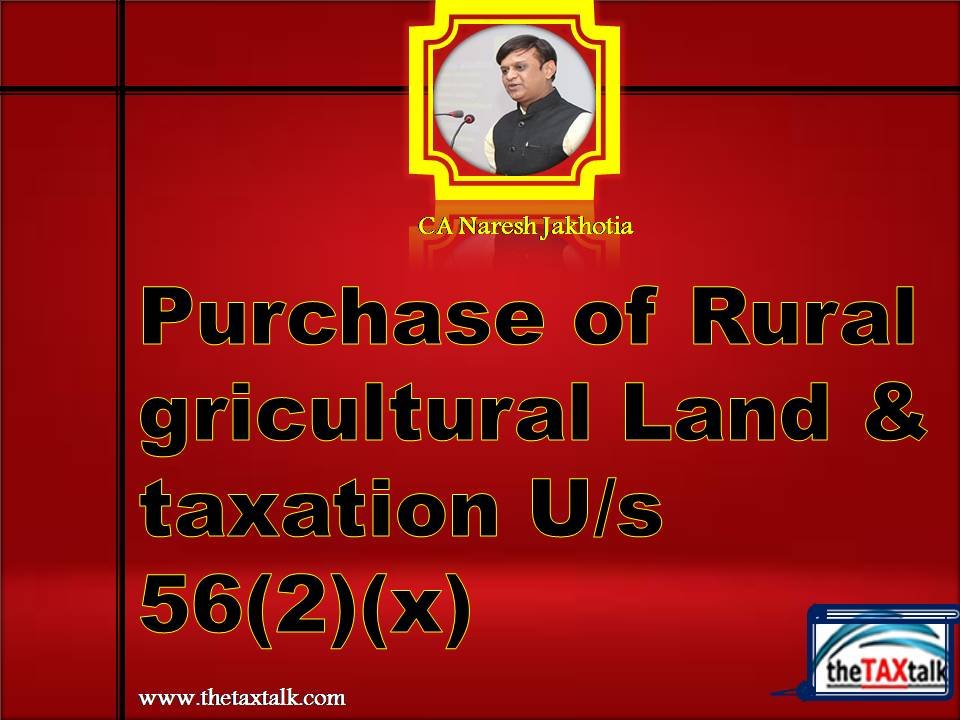![]()
Purchase of Rural gricultural Land & taxation U/s 56(2)(x)
Section 56(2)(x) provides for notional taxation if any property or assets is purchased below its stamp duty valuation. The question which arises is whether the notional taxation provision would be applicable if the immoveable property purchased is a rural agricultural land?
This was the issue involved before Jaipur ITAT in the case of ITO Vs. Shri Trilok Chand Sain wherein the appeal was filed by the department against the order of the CIT and the cross objection was filed by the Assessee as well.
Let us have a short overview of the case:
- This is an appeal filed by the Revenue against the order of the ld. CIT(A), Alwar dated 11.01.2018 for the assessment year 2014-15 and the cross objection filed by the assessee wherein the respective grounds of appeal are as under:-
- Grounds of Appeal filed by the Revenue [ITA No.449/JP2018]
“1. On the facts and circumstances of the case and in law, Ld. CIT(A) has erred in deleting the addition of Rs. 1,51,06,224/- made by the AO on account of difference amount of stamp duty value and purchase value holding arbitrarily view that the land in question is not a capital asset as per the provisions of Section 2(14) of the I.T. Act, 1961.
- On the facts and circumstances of the case and in law, Ld. CIT(A) has erred in reducing the addition from 23,00,000/- to Rs. 8,41,000/- made by AO without appreciating the material facts of the case.”
- Grounds of appeal in the Cross Objection filed by the Assessee [CO No. 10/JP/2018]:
“1. The Ld. CIT(A) has erred on facts and in law in confirming the addition of Rs. 8,41,000/- by treating the source for purchase of land to this extent is unexplained.
- The Ld. CIT(A) has correctly held that the agricultural land purchased by assessee during the year is not a capital asset as per section 56(2)(viib) both on account of the fact that it is a rural agricultural land and otherwise it is stock-in-trade of the assessee and therefore, rightly deleting the addition made by AO under this section.”
- Briefly the facts of the case are that the assessee has purchased three plots of land during the year under consideration and has claimed that these plots of land are agricultural land and doesn’t fall in the definition of capital asset as per the provisions of Section 2(14) of the Act.
- The AO, however invoked the provisions of Section 56(2)(viib) of the Act and made an addition of Rs. 1,74,06,224/- which includes an amount of Rs. 1,51,06,224/- being difference between the sale consideration as per the sale deeds and the stamp valuation determined by the Stamp Valuation Authority, and Rs. 23 lacs as unexplained investment in purchase of these properties. The AO however, accepted the source of expenses incurred on account of stamp duty and other transfer charges amounting to Rs. 9,38,600/-.
- On appeal by the assessee, the ld. CIT(A) has held that the land in question being an agricultural land is not a capital asset as per the provisions of Section 2(14) of the Act and therefore, not being a capital asset, the transaction does not attract the provisions of Section 56(2)(viib) of the Act.
- Further, the ld. CIT(A) has held that the assessee in the business of sale/purchase of property and the land so purchased is his stock-in-trade and since the stock-in-trade is also excluded from the definition of capital asset, on this account as well, the provisions of Section 56(2)(viib) of the Act are not attracted.
- Accordingly, he deleted the addition of Rs. 1,51,06,224/- in the hands of the assessee and granted the necessary relief. He however reduced the addition from 23,00,000/-to Rs. 8,41,000/- made by AO as unexplained investment in purchase of these properties.
- Now, the Revenue is in appeal against the deletion of addition made by the AO and the assessee is in appeal against the addition so confirmed by the ld CIT(A).
- The observation of the ITAT was as under:
“The limited point of dispute is the nature of immovable property which has been purchased by the assessee. The assessee’s contention is that which he has purchased are three plots of agricultural land and the same doesn’t fall in the definition of capital asset as per the provisions of Section 2(14) of the Act and provisions of section 56(2)(vii)(b) cannot be invoked. The Revenue’s contention is that the provisions of Section 56(2)(vii)(b) talks about any immovable property and thus even an agricultural land falls under the definition of an immovable property and the provisions of Section 56(2)(vii)(b) are clearly attracted.
On reading of provisions of 56(2)(vii)(b), we find that it refers to any immovable property and the same is not circumscribed or limited to any particular nature of immovable property. It refers to any immovable property which by its grammatical meaning would mean all and any property which is immovable in nature, i.e., attached to or forming part of earth surface.
In the instant case, the assessee has purchases three plots of agricultural land and such agricultural land is clearly an immovable property.
Whether such agriculture land falls in the definition of capital asset u/s 2(14) or whether such agriculture land is stock-in-trade of the assessee, in our considered view, are issues which cannot be read in the definition of “any immovable property” used in context of section 56(2)(vii)(b) and are thus not relevant.
In the result, we set-aside the order of the CIT(A) to this extent and upheld the order of the Assessing officer. In the result, ground no. 1 of the Revenue’s appeal is allowed”
With this the issue was decided in favor of the Revenue and the purchase of rural agricultural land below its stamp duty valuation was made as liable for taxation U/s 56(2)(x).
1547099187-ITA No. 449JP2018 & 10JP2018 ITO vs


